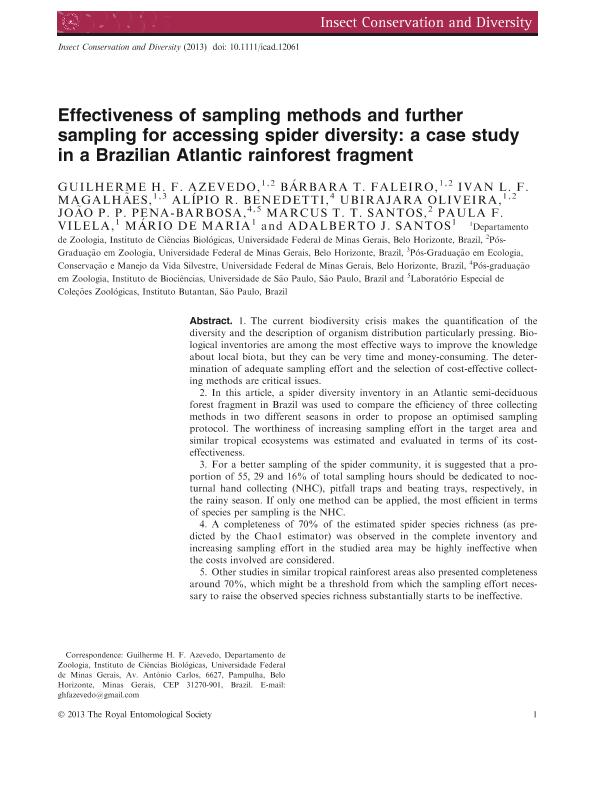Mostrar el registro sencillo del ítem
dc.contributor.author
Azevedo, Guilherme H. F.
dc.contributor.author
Faleiro, Bárbara T.
dc.contributor.author
Fiorini de Magalhaes, Ivan Luiz

dc.contributor.author
Benedetti, Alípio R.
dc.contributor.author
Oliveira, Ubirajara
dc.contributor.author
Pena Barbosa, João P. P.
dc.contributor.author
Santos, Marcus T. T.
dc.contributor.author
Vilela, Paula F.
dc.contributor.author
de Maria, Mário
dc.contributor.author
Santos, Adalberto J.
dc.date.available
2019-09-24T20:18:00Z
dc.date.issued
2014-07
dc.identifier.citation
Azevedo, Guilherme H. F.; Faleiro, Bárbara T.; Fiorini de Magalhaes, Ivan Luiz; Benedetti, Alípio R.; Oliveira, Ubirajara; et al.; Effectiveness of sampling methods and further sampling for accessing spider diversity: A case study in a Brazilian Atlantic rainforest fragment; Wiley-liss, Div John Wiley & Sons Inc; Insect Conservation And Diversity; 7; 4; 7-2014; 381-391
dc.identifier.issn
1752-458X
dc.identifier.uri
http://hdl.handle.net/11336/84327
dc.description.abstract
The current biodiversity crisis makes the quantification of the diversity and the description of organism distribution particularly pressing. Biological inventories are among the most effective ways to improve the knowledge about local biota, but they can be very time and money-consuming. The determination of adequate sampling effort and the selection of cost-effective collecting methods are critical issues. In this article, a spider diversity inventory in an Atlantic semi-deciduous forest fragment in Brazil was used to compare the efficiency of three collecting methods in two different seasons in order to propose an optimised sampling protocol. The worthiness of increasing sampling effort in the target area and similar tropical ecosystems was estimated and evaluated in terms of its cost-effectiveness. For a better sampling of the spider community, it is suggested that a proportion of 55, 29 and 16% of total sampling hours should be dedicated to nocturnal hand collecting (NHC), pitfall traps and beating trays, respectively, in the rainy season. If only one method can be applied, the most efficient in terms of species per sampling is the NHC. A completeness of 70% of the estimated spider species richness (as predicted by the Chao1 estimator) was observed in the complete inventory and increasing sampling effort in the studied area may be highly ineffective when the costs involved are considered. Other studies in similar tropical rainforest areas also presented completeness around 70%, which might be a threshold from which the sampling effort necessary to raise the observed species richness substantially starts to be ineffective.
dc.format
application/pdf
dc.language.iso
eng
dc.publisher
Wiley-liss, Div John Wiley & Sons Inc

dc.rights
info:eu-repo/semantics/openAccess
dc.rights.uri
https://creativecommons.org/licenses/by-nc-sa/2.5/ar/
dc.subject
ARANEAE
dc.subject
BIODIVERSITY ASSESSMENT
dc.subject
COST-EFFECTIVENESS
dc.subject
FAUNAL INVENTORY
dc.subject
NEOTROPICAL
dc.subject
OPTIMISED SAMPLING PROTOCOL
dc.subject
SAMPLING EFFORT
dc.subject
SEASONALITY
dc.subject
STOPPING-RULE
dc.subject.classification
Ecología

dc.subject.classification
Ciencias Biológicas

dc.subject.classification
CIENCIAS NATURALES Y EXACTAS

dc.title
Effectiveness of sampling methods and further sampling for accessing spider diversity: A case study in a Brazilian Atlantic rainforest fragment
dc.type
info:eu-repo/semantics/article
dc.type
info:ar-repo/semantics/artículo
dc.type
info:eu-repo/semantics/publishedVersion
dc.date.updated
2019-09-24T12:51:52Z
dc.journal.volume
7
dc.journal.number
4
dc.journal.pagination
381-391
dc.journal.pais
Estados Unidos

dc.description.fil
Fil: Azevedo, Guilherme H. F.. Universidade Federal de Minas Gerais. Instituto de Ciências Biológicas; Brasil
dc.description.fil
Fil: Faleiro, Bárbara T.. Universidade Federal de Minas Gerais. Instituto de Ciências Biológicas; Brasil
dc.description.fil
Fil: Fiorini de Magalhaes, Ivan Luiz. Universidade Federal de Minas Gerais. Instituto de Ciências Biológicas; Brasil. Consejo Nacional de Investigaciones Científicas y Técnicas; Argentina
dc.description.fil
Fil: Benedetti, Alípio R.. Universidade de Sao Paulo; Brasil
dc.description.fil
Fil: Oliveira, Ubirajara. Universidade Federal de Minas Gerais. Instituto de Ciências Biológicas; Brasil
dc.description.fil
Fil: Pena Barbosa, João P. P.. Universidade de Sao Paulo; Brasil. Governo do Estado de Sao Paulo. Secretaria da Saude. Instituto Butantan; Brasil
dc.description.fil
Fil: Santos, Marcus T. T.. Universidade Federal de Minas Gerais. Instituto de Ciências Biológicas; Brasil
dc.description.fil
Fil: Vilela, Paula F.. Universidade Federal de Minas Gerais. Instituto de Ciências Biológicas; Brasil
dc.description.fil
Fil: de Maria, Mário. Universidade Federal de Minas Gerais. Instituto de Ciências Biológicas; Brasil
dc.description.fil
Fil: Santos, Adalberto J.. Universidade Federal de Minas Gerais. Instituto de Ciências Biológicas; Brasil
dc.journal.title
Insect Conservation And Diversity

dc.relation.alternativeid
info:eu-repo/semantics/altIdentifier/doi/http://dx.doi.org/10.1111/icad.12061
dc.relation.alternativeid
info:eu-repo/semantics/altIdentifier/url/https://onlinelibrary.wiley.com/doi/abs/10.1111/icad.12061
Archivos asociados
